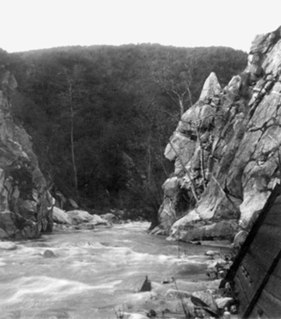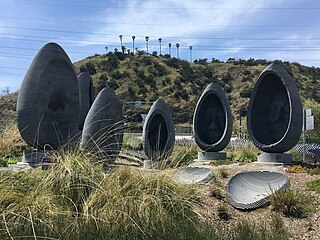
Cypress Park is a densely populated, 82.1% Latino neighborhood of 10,000+ residents in Northeast Los Angeles, California. It sits in the river valley created by the LA River and the Aroyo Seco, and is surrounded by hills on three sides. It is the site of the Rio de Los Angeles State Park, the LA River Bike Path and other recreational facilities. It hosts one private and four public schools.
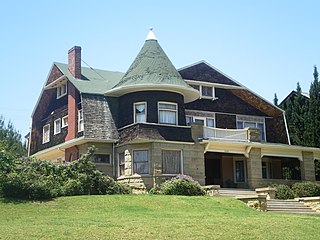
Alvarado Terrace Historical District is a designated historic district in the Pico-Union district of Los Angeles, California. It is located southwest of Downtown Los Angeles, along Alvarado Terrace between Pico Boulevard and Alvarado Street.

The former First Church of Christ, Scientist, built in 1912, is an historic Christian Science church edifice located at 1366 South Alvarado Street in Pico-Union, Los Angeles, California.
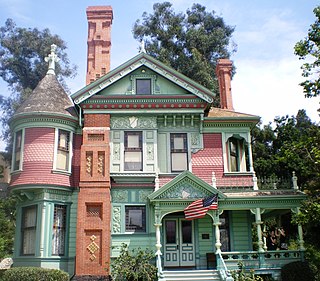
Hale House is a Queen Anne style Victorian mansion built in 1887 in the Highland Park section of northeast Los Angeles, California. It has been described as "the most photographed house in the entire city", and "the most elaborately decorated". In 1966, it was declared a Historic-Cultural Monument, and in 1972 it was listed on the National Register of Historic Places. The house was relocated in 1970 to the Heritage Square Museum in Montecito Heights where it remains open to the public.
The Lydecker Hilltop House is an art deco house and film location in Los Angeles, California designed by Howard and Theodore Lydecker. It was designated a Los Angeles Historic-Cultural Monument by the City of Los Angeles on May 14, 2008.
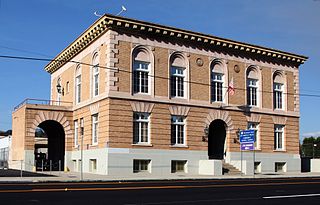
The Highland Park Police Station on York Boulevard in the Highland Park section of Los Angeles, California, USA is the city's oldest surviving police station. Closed in 1983, the station is now operated as the Los Angeles Police Museum. It has been designated as a Historic Cultural Monument and listed on the National Register of Historic Places.

The North University Park Historic District is a historic district in the North University Park neighborhood of Los Angeles, California. The district is bounded by West Adams Boulevard on the north, Magnolia Avenue on the west, Hoover Street on the east, and 28th Street on the south. The district contains numerous well-preserved Victorian houses dating back as far as 1880. In 2004, the district was added to the National Register of Historic Places.

Shadow Ranch is a historic ranch house, built from 1869-1872 using adobe and redwood lumber, on the original Workman Ranch in the western San Fernando Valley of Los Angeles, California. For much of the 20th century it was in Canoga Park, but it is now within the boundaries of the West Hills community.

Old St. Peter's Episcopal Church is a Los Angeles Historic-Cultural Monument located in the San Pedro section of Los Angeles, California, near the Port of Los Angeles. Built in 1883 in the Carpenter Gothic Victorian architecture style, it is San Pedro's oldest church.

The James H. Dodson Residence is a Los Angeles Historic-Cultural Monument located in the San Pedro community of Los Angeles, California, near the Port of Los Angeles.

Harbor View House, formerly the Army and Navy Y.M.C.A., is a Los Angeles Historic-Cultural Monument located in the San Pedro section of Los Angeles, California, near the Port of Los Angeles. It is a five-story Spanish Colonial Revival style structure located on a bluff overlooking the harbor.

Forthmann House, now known as USC Community House, is a Los Angeles Historic-Cultural Monument located in the North University Park Historic District of West Adams, Los Angeles, California. It is a 4,200-square-foot (390 m2) Victorian house built c.1887, designed by Burgess J. Reeve. It was relocated in 1989 from its original location. A secondary structure known as the Forthmann Carriage House was moved from its original location to its new home in Angelino Heights at 812 E Edgeware Rd.

The Montecito View House, located at 4115 Berenice Place in Montecito Heights, Los Angeles, is a Craftsman bungalow designed by architect Lester S. Moore and built in 1909. It was one of the very first homes constructed in Montecito Heights, and was featured on the cover of the Mutual Building Company's advertising pamphlet. Interesting aspects of the home include clinker brick and Arroyo stone chimney. The style is reminiscent of the work of Greene and Greene, Pasadena.

Wellington Square is a neighborhood in Mid-City Los Angeles, California at the western edge of the West Adams Historic District.

First Baptist Church of Los Angeles is a Baptist church located at 760 South Westmoreland Avenue in Los Angeles, California. It was designated Los Angeles Historic Cultural Monument 237 in 1981.
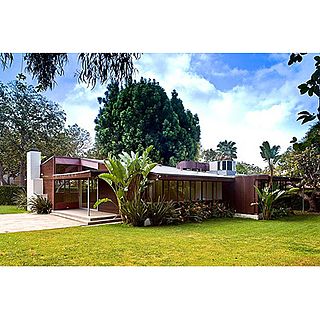
Neutra/Maxwell House, referred to as the Maxwell House, is a Los Angeles Historic-Cultural Monument located in Angelino Heights, Los Angeles, California. It is a 1,200-square-foot (110 m2) Mid-Century modern house built c.1941, designed by Richard Neutra. It was relocated in 2008 from its original location at 475 North Bowling Green Way in Brentwood, Los Angeles thanks to the efforts of Barbara Behm. The Charles and Sylvie Maxwell House was designed and built by Neutra for the two musicians, she a violinist and he a composer, who wanted "acoustically suitable living quarters" on a budget of $6,750. Her practice room is farthest away from the composers study. There is a nice integration of sloping and flat roofs with the introduction of a glass triangle into the redwood siding. It was with this project that Neutra first experimented with the peaked roof and triangular glazed gable openings that later became a trademark of the firm when pitched roofs were mandated by city building codes. Further, this design element profoundly influenced the design of American suburban architecture in the 1950s and 60's.



